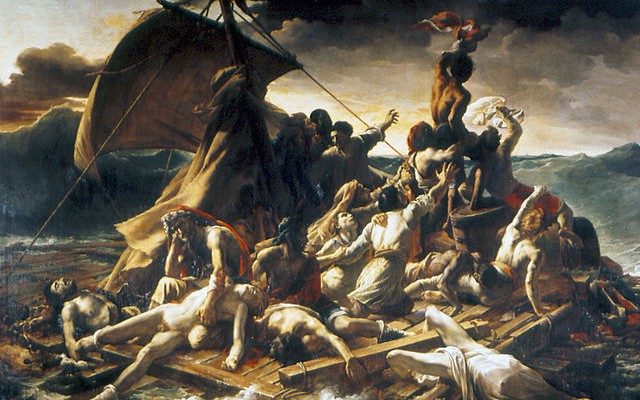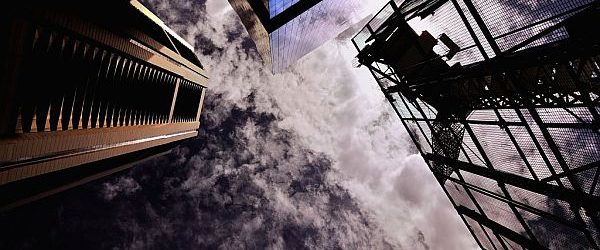Where there’s shit, there’s a system. This is what art historian EG Grigsby had to say about Géricault’s 1818–1819 Raft of the Medusa. An incredibly violent and disturbing painting that shows a selection of, in Grigsby’s terms, ‘partially consumed bodies’. Raft of the Medusa is populated by soldiers, working-class French and non-white colonial subjects, and slaves – by bodies that are owned, controlled, and consumed by society, that are used for others’ benefit rather than their own.
The painting depicts the horrific thirteen-day ordeal suffered by 146 men and one woman in the wake of the sinking of the frigate Méduse in 1816. Without enough longboats to go around, the less powerful were bundled onto a raft that was to be towed to shore, thirty miles away. But once on the open sea, the boat navigators realised the plan was impractical. The ropes were cut, and the raft left to drift at sea where the situation soon turned violent; there were fights, over-boards, murder, and, with rations eventually depleted, cannibalism. The salacious details were meticulously recorded in the newspapers when the survivors – just fifteen men – were rescued.
Like the social categories which determined who would be in the longboat and who on the raft back on the Méduse, it was initially those who held more power in society – the white men, those from higher social classes and so on – who survived on the raft. But, as the situation grew more dire, as rations dwindled and the threat of exposure grew, social categories no longer mattered; it was the fittest, the strongest, who pulled through, who were able to subjugate and destroy the bodies around them to ensure their own survival. In Géricault’s painting, the lack of clothing – that traditional marker of wealth and class – and the confusion of the colour of the bodies depicts this shift of power from social to bodily. Grigsby’s reading of the painting argues that Géricault neither celebrates nor condemns this shift. Rather, the importance of the painting lies not in who holds power, but in the fact that those who are in power ‘consume’ less powerful bodies for their own gain.
It is those bodies designated by society as fit for consumption that come to be classified as ‘shit’, and the bodies who do the consuming that reflect the system.
In Australia – a wealthy and democratic country – we have a wealth of ‘shit’. But most of ‘it’ is invisible: the imprisoned refugees hidden in the torture prisons on Nauru and Manus islands; the homeless people of Melbourne who will soon be removed from the city’s centre; Indigenous peoples whose individuality and personhood is obscured by the tabloid spectre of blackness that links Indigeneity to alcoholism, barbarity, and violence.
Indeed, this invisibility is key to the process of consuming these bodies: of turning these people – people with hopes and dreams and fears and feelings and failings – into objects undeserving of sympathy or even basic thought. The system of Australia relies on these bodies in order to continue to function as it currently does, but that fact must remain unspoken and thus unthought.
Consider this: Australia is a democratic country with high living standards; it is one of the most successful multicultural societies in the world; it boasts some of the world’s most liveable cities; access to education, healthcare, and basic human necessities is almost ubiquitous; people are generally happy and healthy.
But this only holds for the community of Australia.
Of course, there are scales of community – neighbourhoods; cities; family, friends, and other kinship groups – but the community of Australia encompasses those understood by the nation as having a legitimate or official claim to that community. A no less slippery term, by ‘nation’ what I am trying to get at is the recognition that some bodies – some kinds of people – are held in higher regard than others because of external social markers and factors. This regard manifests in formal and informal markers of privilege and acceptance such as citizenship, ethnicity, language, and accent; sameness to the dominant social group.
In her latest book, Notes Towards a Performative Theory of Assembly, gender studies scholar Judith Butler argues that bodies presuppose community. That is to say, a body is only unsafe or precarious insofar as it is deemed by wider society to be less important. A woman walking home alone at night is in danger because society as a whole allows for the continued assumption that a woman’s body is worth less than a man’s.
Within the community of Australia, there are indeed precarious bodies: women, LGBTIQA people; poor people; permanent residents and migrant citizens. Yet each of these groups still belongs undoubtedly to the community of Australia. This is not to lessen the negative affects that the distribution of power along lines of class, race, and gender to wealthy white Australian-born cis-men creates. But I want today to consider the bodies who do not even make it into the category of ‘precarity’. The ‘shit’ of Australia: those bodies that must be destroyed, consumed, made inhuman and invisible, in order for the system of Australia to continue. I want to look – and I want others to look – at those who are made abject by contemporary Australia.
According to Julia Kristeva in Powers of Horror, the abject is neither subject nor object; it is that which exists on the edges of society, which disrupts and disturbs system, order, and identity – a lifeless corpse reminding a still-living body of its own mortality, for example. The abject is the taboo which must be rejected in order for one to function in the society that has been created around them. Certain incarnations of the abject exist across cultures: death, excrement, blood, the woman’s body. Others are contingent on their context, and it is these which can tell us more about the ‘subjects’ and ‘objects’ against which they are defined, than about the abject thing itself.
The refugees held in off-shore detention and denied safety, security, basic medical care, human rights, and dignity, remind us not only of the high living standards enjoyed by most Australians, but also how fragile such a life is.
The homeless people on the streets of Melbourne without friends, family, or a government-funded safe space to take them in for a night, without access to employment, housing, basic amenities, or regular food, remind us of the cost associated with a neo-liberal ideology predicated on a Darwinian survival-of-the-fittest worldview, and to reconsider the fundamental assumption that this worldview has internalised within us: that personal wealth is inherently linked to morality and virtue.
And the Indigenous body long abused, imprisoned, enslaved, removed from country, culture, and language, and denied access to either the wealth of Australia or a return to country reminds us that everything we have and everything we do is predicated on theft and bloodshed.
If we are drawn into a circle of ‘community’ that inherently denies these bodies personhood or access to that community, then we contribute – however inadvertently – to their consumption. If we do not look back over those boundary lines of community, we contribute to re-making these people as objects in order to ensure our own continued unproblematic existence as subjects.
We must force a re-drawing of the boundaries so that these people – so that all people – are gathered into our community. We must stand in solidarity with those who are vulnerable, those who are consumed, those who are abjected. And this solidarity must begin with making these bodies visible.
To be sure, there are those already doing this – both from these groups and from the ‘community’ of Australia.
There are numerous Indigenous activists, writers, and artists helping to build a nuanced and empathetic image of the people who have survived the invasion of their country and this has resulted in a growing understanding of the pain and anguish that celebrating nation on Invasion Day causes to Indigenous people, for example.
Similarly, the response to the Homeless Ban in Melbourne has been swift and vocal both in the streets and on social media.
Medical, legal, and other volunteers on Nauru and Manus have long attempted to circumvent the bipartisan government gag on reporting or photographing conditions in the prisons. And the new collection of short stories They Cannot Take The Sky (in release March 2017) attempts to do this from a slightly different vantage. The extent of its success in bringing to light the subjecthood of those Australia has chosen to forget could evidence a need for ever-changing and evermore creative ways of making visible that which is hidden.
We must fight to make these bodies – and their treatment and their experiences – visible, known, empathised and sympathised with. Because it will be that visibility that will force a reappraisal of these bodies away from the abject and towards precarity.
And then the real work begins.



